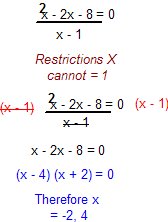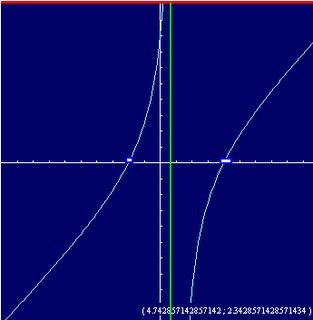Hi guys! .. Well, sorry for the wait. By the way, HAPPY HALLOWEEN. (=
Today was a pretty easy class. We did a pretest, which wasn't included for marks. Everyone for the most part understood the first page. So I'll just briefly go over those questions first. =)
1. The sum and product of the roots of the quadratic equation 2x2 + 2√(3)x - √(6) = 0 are:
A) √(3) and √(6)
B) -√(3) and √(6)/(2)
C) -2√(3) and -√(6)
D) -√(3) and -√(6)/(2)
The answer would be D. If we remember from previous class lessons, the sum is the negative of b, and the product is the same as c.
2. The Equation x2 + 3x - 2 = 2 has:
A) 2 different negative numbers in its solution set.
B) only 2 solutions and they are both positive.
C) only two solutions
D) no solution
E) none of the above.
The answer for this question was A. This is how we solved it.
Case 1:
x2 + 3x - 2 = 2
x2 + 3x - 4 = 0
(x+4)(x-1) = 0
x = -4, x = 1
Case 2:
x2 + 3x - 2 = -2
x2 + 3x = 0
x(x+3) = 0
x = 0, x = -3
With these solutions, every single one will work when placed into the equation. Because two of the 4 solutions are negative (-), option A, is therefore true.
3. Solve: (2x)/(x-1) = (x)/(x+1) + 1
For this question, we're solving for x. So basically, you multiple each side by the LCD (Lowest Common Denominator). Which happens to be: 1(x-1)(x+1). By doing that we end up with this.
2x(x+1) = x(x-1) + (x+1)(x-1)
From here on, we solve for X.
2x2 + 2x = x2 - x + x2 - 1
3x = -1
x = -1/3
Therefore the answer to this question is x = -1/3
4. Given the following quadratic equations, use the discriminant to determine which of the following have two real solutions.
A) 3x2 + x - 2 = 0
B) x2 - 2x + 1 = 0
C) -x2 - 12x - 5 = 0
NOTE: The Discriminant is b2 - 4ac
Now we solve each other them:
A) (1)(1) - 4(3)(-2)
1 + 24
25 <-- TWO REAL SOLUTIONS.
B) (-2)(-2) - 4(1)(1)
4 - 4
0 <-- ONE REAL SOLUTION.
C) (-12)(-12) - 4(-1)(-5)
144 - 20
124 <-- TWO REAL SOLUTIONS.
Therefore, A and B have two real solutions! .. =)
Time for the question we all seemed to be stumped on:
 5. A river is 5 miles wide. A point C is 10 miles downriver from the point directly across the river from point A. Point B is x miles from the point directly across the river from A. A person swims 3 miles/hour from A to B and runs 5 miles/hour from B to C. Find x if it takes the person 3 hours and 20 minutes to travel from A to B to C.
5. A river is 5 miles wide. A point C is 10 miles downriver from the point directly across the river from point A. Point B is x miles from the point directly across the river from A. A person swims 3 miles/hour from A to B and runs 5 miles/hour from B to C. Find x if it takes the person 3 hours and 20 minutes to travel from A to B to C. Hint: Distance = (rate)(time)
First we start off with finding the total time it took for the person to get this distance.
Time: 3 h 20 min = 3 1/3 hrs or 10/3 hrs.
 Secondly, we need to find AB, and BC.
Secondly, we need to find AB, and BC.
AB:
- We know that by using the pythagorean theorem that a2 + b2 = c2
- Therefore x2 + 52 = AB
- And √(x2 + 25) = AB
BC:
- we know the total distance from the point directly across the river from A and C is 10 miles.
- Therefore BC = (10 - x)
Know that we know what AB and BC are, we can look for the equation.
swim time + run time = total time
√(x2 + 25) / 3 + (10 - x) / 5 = 10 / 3
Now we find the LCD again and solve for x!
- First we multiply everything by 15, and we end up with this:
5√(x2 + 25) + 30 - 3x = 50
5√(x2 + 25) = 3x + 20
- To get rid of the radical we have to square both sides!
(5√(x2 + 25))(5√(x2 + 25)) = (3x + 20)(3x + 20)
25(x2 + 25) = 9x2 + 120x + 400
25x2 + 625 = 9x2 + 120x + 400
16x2 - 120x + 225 = 0
- Now that we've found that and it isn't factorable, we use the quadratic formula to solve for x.
x = 120 ± √(14400 - 4(16)(225)) / 2(16)
x = 120 ± √(14400 - 14400) / 32
x = 120 ± √(0) / 32
x = 120 / 32
x = 60 / 16
x = 30 / 8
x = 15 / 4
And there you have it! .. This question covers most of the things we did in this unit. It's challenging, but it won't be on our tests nor our exam. So that's it! ..
Homework was posted by Mr. K earlier.
And our next scribe will be....
CRYSTA! . haha. have fun =)













